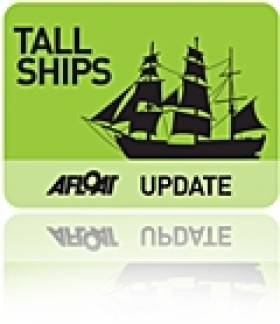Displaying items by tag: JOHANNA LUCRETIA
Irish Sea Tall Ships Regatta is Finally Underway
#TALLSHIPS – As previously reported on Afloat.ie, the first Irish Sea Tall Ships Regatta, which was postponed on Sunday due to adverse weather, set off yesterday afternoon from Dun Laoghaire Harbour, writes Jehan Ashmore.
The majority of the 11-strong fleet did not return to Dublin Port after the Parade of Sail, but instead took shelter in Dun Laoghaire Harbour. This gave curious onlookers in the harbour an opportunity to see the vessels up close and personal, as they berthed alongside Carlisle Pier. The inaugural race consists only of a single leg and that is to Liverpool.
Among the fleet were the Dutch gaff schooner De Gallant, and three UK vessels, the ketch Maybe, the barquentine Pelican of London and another gaff schooner Johanna Lucretia. Several years ago the 96ft vessel built in 1945, had replaced the original vessel used in the RTE reality show 'Cabin Fever' after the Camaret of Cornwall, ran aground off Tory Island, Co. Donegal.
Dunmore East Bids TallShips Farewell
As the Russian 'A' class Mir passed the LE Aoife off Dunmore East in mid-morning, the largest tall ship of the festival headed the start of the Parade of Sail, writes Jehan Ashmore.
Crowds left their cars in fields outside Dunmore East and descended into the harbour and surrounding headlands to witness the highlight of the four-day festival. Adding to the scene were the numerous leisure-craft, yachts and intrepid kayakers that gathered to greet the procession which took some two hours to pass the fishing harbour.
No sooner had the fully-rigged ship Mir had slipped beyond the anchored naval vessel that the gaff schooner Johanna Lucretia, under full sail came closer into view. She was closely followed by the Ocean Youth Trust Scotland's Bermudan cutter Alba Explorer.

The Russian 'A' class Mir passing the LE Aoife off Dunmore East. Photo: Jehan Ashmore
Of all the 45 tallships participating the Columbian Navy's barque ARC Gloria presented the most colourful entrant. She proudly flew a large horizontal tricolor of yellow, blue and red representing the South American nation.
When it came to the turn of the Europa to pass the LE Aoife, the tug Bargarth gave a wonderful send-off with the traditional display of water jets shooting sky-high, nearly reaching the top of the three-masted barque.
Marking the tail-end of the parade was the Jubilee Sailing Trust's Lord Nelson, another barque that departed the estuary with the Hook Head Lighthouse forming a majestic backdrop.
At this stage several of the large tallships could be seen on the far horizon in preperation to the start of the first race leg of this years Tall Ships Races....next port of call Greenock!
- Waterford
- ship
- Dunmore East
- Lord Nelson
- Waterford Estuary
- LE Aoife
- Sail Training International
- Jubilee Sailing Trust
- Tug
- Hook Head
- Tall
- JOHANNA LUCRETIA
- TallShips
- Waterford Harbour
- JST
- Europa
- Fullyrigged ship
- STI
- ARC Gloria
- Hook Head Lighthouse
- Mir
- Gaff schooner
- Ocean Youth Trust Scotland
- Bermudan cutter
- Alba Explorer
- Columbian Navy barque
- Bargarth
- Fastnet Shipping
Navies Northern Adventure Head for 'Foyle Days'
On the naval front, LE Emer was built in Cork's Verolme Dockyard in 1978. She represents the oldest of the eight-strong fleet and is designed from the Naval Service's first purpose built patrol vessel OPV LE Deirdre (P20) but was modified to improve her stability and speed. This vessel was decommissioned several years ago and was converted into a private yacht.
The original BOFORS 40mm L60 gun of the LE Emer was recently upgraded to a BOFORS 40mm L70 to improve range and accuracy of her main armament. She alongside her 65m sisters LE Aoife (P22) and LE Aisling (P23) where all built primarily to patrol the Irish section of the European Economic Zone (EEZ).
During their careers the 'Emer' class vessels have also completed numerous re-supply missions to Irish troops serving overseas with the United Nations and in particular in the Lebanon. A crew compliment of 46 (5 officers) operate the vessels which are all now in their fourth decade of service.
OPV HMS Severn is the third of four 'River' class offshore patrol vessels and like her Irish counterpart is deployed on fishery duties. The 1,677 displacement tonnes vessel was built in 2001 in the UK'S south coast port of Southampton at Woolston Docks. Her home port for the 30 crew is at HM Naval Base in neighbouring Portsmouth.
She becomes the fifth ship to bear the name and with sisters HMS Mersey (P 282) and HMS Tyne (P 281) they are assigned to the Fishery Protection Squadron. Click the ship's diary to follow the ship news. The final member of the River class HMS Clyde (P 257) serves as a Falklands Islands Patrol Vessel (FIPV).
- yacht
- Clipper Round The World Race
- naval service
- Derry
- Royal Navy
- Londonderry
- Ports and Shipping News
- JOHANNA LUCRETIA
- Verolme Cork Dockyard
- United Nations
- Foyle Days
- Offshore Patrol Vessel
- Maritime Festivals
- LE Emer
- Emerclass
- LE Deirdre
- HMS Mersey
- Riverclass
- Schooner
- HM Naval Base Portsmouth
- Falklands Islands
Boats Head for 'Foyle Days' 2011
Over the years she has changed hands between Dutch and UK interests for recreational use. Several years ago she starred in the RTE TV reality show 'Cabin Fever' where she replaced the show's first ship Camaret of Cornwall (branded as 'Cabin Fever') after it ran aground off Tory Island.
During the two-day festival (11am-5pm) the boating community at the event will include the Coleraine Yacht Club, Foyle Paddlers, Foyle Punts, Lough Foyle Yacht Club, Lough Swilly Yacht Club, Moville Boat Club, RNLI and the Foyle (SAR) Search and Rescue.
Visitors to Foyle Days can call to the Clipper stand and learn more about the city's entry of the Derry~Londonderry boat in the 2011-2012 Clipper Round the World Race. Learn more about the countries the crew will visit and also how to get involved in the event. For more information about the race, at 40,000 miles is the world's longest race go to www.clipperroundtheworld.com/
Running alongside the festival a continental market with 40 stalls will be open to all at the recently revamped Guildhall Square. For further details about Foyle Days click here.
- Clipper Race
- Maritime Festival
- RNLI
- Lough Foyle Yacht Club
- Lough Swilly Yacht Club
- Moville Boat Club
- Derry
- Londonderry
- Tory Island
- JOHANNA LUCRETIA
- Foyle Days
- RTE TV
- Cabin Fever
- Camaret of Cornwall
- Grounding
- Reality TV show
- Clipper Around the World Race
- Guildhall Square
- Continental Market
- Coleraine Yacht Club
- Foyle Search and Rescue
- Foyle Paddlers
- Foyle Punts
- Offshore Sailing
- Clipper Round The World Race
- JOHANNA LUCRETIA
Now There is None
What a magnificent sight it was as the three Tall Ships, each flying the Tricolour, headed the fleet of the gracious ships of sail from all over the world.
How different it will be in July when the world's Tall Ships again parade down the Suir. There will be no Irish national sailing ship to lead the parade. A number of private Irish entries are expected at Waterford from June 30–July 3 amongst the 70 vessels from around the world when the city has the honour starting the race. In 2005 about half-a-million people visited the city while the Tall Ships were there.
The lack of a national tall ship is another example of governmental maritime neglect, directly due to the decision of former Defence Minister Willie O'Dea, T.D. After the sinking of ASGARD he publicly committed the Government to its replacement, but after receiving insurance compensation money for its loss, he put the money into coffers of the Department of Finance and closed down the national sail training programme. There was a big difference between what he promised and what he did, a disregard for the maritime sphere which it is hard to forgive. I also recall how former Taoiseach Bertie Ahern did not visit Waterford during the 2005 race, when it was the biggest tourist event in the country. When I broadcast my report expressing astonishment at this snub government sources and Fianna Fail didn't like it. Truth in the news can be painful!
The organisers made contacts about the DUNBRODY, which continues to earn income at the New Ross quayside where it is moored as a tourist attraction and with the JEANIE JOHNSTON, moored at the Dublin Docklands.
However, neither will be taking part, the organisers have confirmed, tough they said that it was expected that about 100 young Irish trainees would sail aboard tall ships in the race, half of them with funding support from local authority, business and other sources. A group of Irish sailors have also indicated they are making arrangements to charter a UK-registered vessel the JOHANNA LUCRETIA for the event.
Once again the Irish Government has sunk to the bottom where maritime matters are concerned.
It was announced this week in Waterford that Fáilte Ireland has made a significant financial and marketing commitment to this year's event, though the financial figure was not disclosed .A free festival programme will feature street acts; comedy; international and home-grown artists, nightly fireworks, an artisan food village and an atmosphere which the organisers say "will thrill people of all ages and nationalities."
• This article is reprinted by permission of the EVENING ECHO newspaper, Cork, where Tom MacSweeney writes maritime columns twice weekly. Evening Echo website: www.eecho.ie
































































